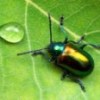A clarification, relevant the discussion below:
 Tree from Brady et al 2006.
Tree from Brady et al 2006.
More like this
...well, not really. But an exchange I had at Photo Synthesis with Andrew Bleiman of Zooillogix got me thinking about all the diffe
Reader Sam Tomkinson has been experimenting with my tracing-paper diffusion trick and took this lovely shot of a Myrmecia bull ant in western Australia:
Today, it's the New York Times. Consider this Q & A:

So does your clarification mean that Myrmecia is not primitive, but you would entertain the notion for the h-lineage (or is this just an outgroup?) or the b-lineage?
Looks like (my eyes aren't so good) that Prot- and Pro- show up in several of the genera there, implying someone once thought them first on the scene.
Dave- not at all. I don't think the term "primitive" has much meaning in a phylogenetic context, so it wouldn't correctly refer to any of the branches. As a case in point, one might naturally think of the Leptanillines (the "h-group") as primitive from their position, but Leptanilla is also on a rather long branch. That means they've undergone more molecular evolution than most ants. So it's while it's a remarkably old lineage, it is also one of the most evolved.
What I mean to demonstrate here is that Myrmecia is a relatively young lineage.
Young? How does one determine age from the cladogram?
Apart from fossil-calibrated dating analyses (which were also done for this study), one can determine relative age from the patterns of nestedness.
We know, for example, that Myrmecia must be younger than the early formicoids, as it is contained within the formicoid clade.
I checked the article you linked and they cite one of their earlier works (Geiner et al. 2007 Curr Biol 17) in support, but that paper just declares Myrmecia primitive:
"Here we report striking correlations between the timing of foraging bouts and the modification of eye structure in four species of ants belonging to the primitive genus Myrmecia." (p. R879, second sentence)
So, you clearly have a point that this is a gratuitous and apparently ignorant use of 'primitive'.
I think my point is that you can't have primitive without also having 'advanced' and this is one of many dichotomies we use when telling stories. I've started to see these rhetorical tools as limiting, because you become trapped by the implications. Whether or not we can do away with them and still communicate effectively, I'm not sure. In any case, most people seem to need to divide things into two groups when discussing them.
They say there are two kinds of people in the world. Those that divide things into two groups, and those that don't...
:)
By the same token, it does not seem very yuong within the formicoids.
And you're right: it's a pretty old formicoid. But age is also relative to expectation, and I think there was a fair expectation after the chatter about Nothomyrmecia being the "most primitive living ant" that the myrmeciines were a potential sister to the remaining extant ants. When they turn up instead as nested higher in the phylogeny and close to "higher" ants like Dolichoderines, that wasn't what a lot of people expected.
If anything, I'd not mind referring to myrmiciines as relictual. After all, that group was once found worldwide but for whatever reason is now extinct everywhere but Australia.
Aha! Relictual, got you right where I wanted!..